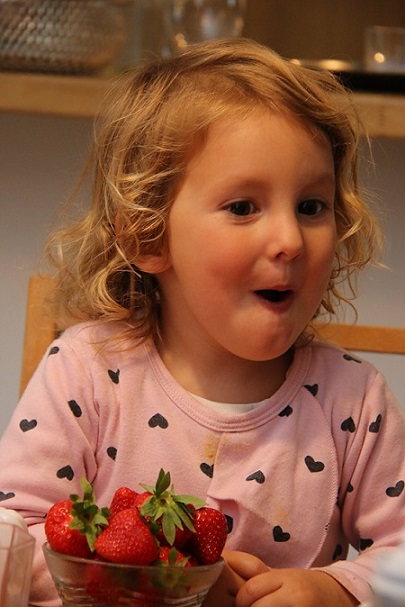This concept is an important step from early childhood, especially when it comes to eating. There are so many expectations from parents around meals today. We want a balanced diet, a mindful diet, a healthy diet, and we can no longer identify with a traditional approach.
I suggest incorporating new benchmarks and good habits while letting go of old beliefs for a more playful approach. So in practice, how do you practice autonomous eating ?
Meals are generally considered a time for sharing.
Eating for a child is not just about nourishing the body; it is also a moment of discovery, sharing, and connection with loved ones. This is especially true for young children. It is worth considering meals as a way to bond with family and to feel a sense of belonging.
When children are involved in choosing their meals and adults practice autonomous eating, it becomes a wonderful opportunity to express their preferences and explore the sensory possibilities that food offers. The benefits should be considered for overall motor development, particularly motor skills such as hand-mouth coordination, cleanliness, and hygiene, which are also pillars of health. Even if social codes seem outdated to us, neglecting hand washing is out of the question.
Here are 5 keys to help children's autonomy:
1) Mimicry:
This is THE secret to a peaceful learning experience. At mealtime, I first make a trip to the bathroom, wash my hands, sit down, and relax. I create a calm atmosphere even if I have little time, and I admire everything that is offered on the table, commenting on each step out loud, of course. It's more fun to share in a friendly atmosphere.
The notion of pleasure is essential, just as much as the notion of diet.
I breathe while eating. Choupinou will only have one desire, which is to do like you, and the struggle over all those little tasks that, if done in confrontation, tarnish the mealtime moment will be over. The same goes for food; enjoy yourself like a clown with a black radish, and it will go from being a suspicious new food to your child's favorite vegetable! I would even go further, pronounce joyful "please" and "thank you," and it will no longer be about following rules of politeness but truly an ode to life...
Learning about meals often extends beyond the plates without us being aware of it.
2) Sensuality:
Opt for cheerful and pretty tableware; you can find treasures at flea markets. Make sure everything is pleasant to the touch. Adapt the tableware to the child's age.
Why not a compartmentalized plate, a suction plate? A wooden plate, easy to wash by oneself like a grown-up rather than a plastic plate?
Favor eating with your hands or wooden utensils. Focus on beautiful presentations; the colors of the food are an asset for creating something visually appealing. You can mimic Japanese bentos, opt for a tray meal, or even eat at a small table, for example.
Eating engages all our senses: smell (what a joy to smell melons or strawberries!), taste, touch, sight, and of course, hearing. Diversify the textures; carrots can be whole, sliced, in sticks, mashed, or grated, and the abundance of choices provides a precious sense of freedom for autonomy.
3) Availability:
Focus your attention on the child and make mealtime a moment of togetherness. The television and computer are turned off, and the phone is set aside. Take the time to describe each food together, its color, its texture, where it comes from; our little ones love beautiful stories.
Availability is essential when it comes to allowing children to be independent at mealtimes. One of the best ways to encourage this independence is to ensure that meals take place at regular times each day, like scheduled moments of sharing. This helps children develop a routine and understand when they can expect to eat.
4) Do It Yourself:
"Getting your hands dirty," does that ring a bell? Then become a master chef by preparing meals with four little hands. Selecting, washing, scrubbing, drying, cutting, mashing, isn't it great? Praise the help provided in the kitchen; their self-esteem and confidence will make them more independent.
Involving your child in meal preparation and organization is not only a fun activity that allows for bonding, but it is also a way to teach them valuable skills and promote their independence. When children participate in meal preparation, they are more likely to try new foods and develop healthy eating habits.
Start by involving your child in the meal planning process. Let them choose the ingredients at the grocery store or market and talk to them about the nutritional benefits, taste qualities, and how to properly store them. Encourage them to participate in simple tasks like washing fruits and vegetables, mixing ingredients, or setting the table. As they grow older, you can give them more responsibilities in the kitchen, such as cutting vegetables, following recipes, and eventually preparing meals on their own.
By allowing your child to take an active role in meal preparation, you help them acquire important life skills and foster a positive relationship.
5) Patience:
Of course, trust him, but most importantly, trust yourself! In a relaxed atmosphere, the appetite opens up and varies as well, so don't worry about the quantities. Look over periods of 3 or 4 days to include new foods and balance the nutrients he needs to grow well and understand what suits him. Take the time to teach him to be independent, it's a winning bet !
When it comes to giving your child the autonomy to choose their own meals, the task can sometimes seem overwhelming. However, it is important to remember that as a parent, you know your child best. It is essential to trust yourself and rely on your instincts to create a relaxed atmosphere at mealtime.
As a reminder: it is normal for a child's appetite to vary from day to day.
Conclusion:
In conclusion, a child's self-feeding represents much more than just a dietary habit. It embodies a special moment of sharing, discovery, and bonding between the child and their loved ones.
By adopting a playful approach and encouraging the active participation of the child in the preparation and tasting of meals, we not only promote their autonomy but also their motor, sensory, and emotional development. Patience, availability, and creativity are key to cultivating a healthy and positive relationship with food, allowing the child to fully flourish and grow in a nurturing and caring environment.









